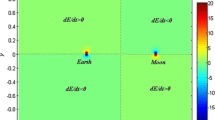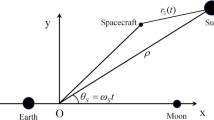Abstract
An analysis is presented of gravity assisted flybys in the planar, circular, restricted three-body problem (pcr3bp) that is inspired by the Keplerian map and by the Tisserand- Poincaré graph. The new Flyby map is defined and used to give insight on the flyby dynamics and on the accuracy of the linked-conics model. The first main result of this work is using the Flyby map to extend the functionality of the Tisserand graph to low energies beyond the validity of linked conics. Two families of flybys are identified: Type I (direct) flybys and Type II (retrograde) flybys. The second main result of this work shows that Type I flybys exist at all energies and are more efficient than Type II flybys, when both exist. The third main result of this work is the introduction of a new model, called “Conics, When I Can”, which mixes numerical integration and patched conics formulas, and has applications beyond the scope of this work. The last main result is an example trajectory with multiple flybys at Ganymede, all outside the linked-conics domain of applicability. The trajectory is computed with the pcr3bp, and connects an initial orbit around Jupiter intersecting the Callisto orbit, to an approach transfer to Europa. Although the trajectory presented has similar time of flight and radiation dose of other solutions found in literature, the orbit insertion Δv is 150 m/s lower. For this reason, the transfer is included in the lander option of the Europa Habitability Mission Study.
Similar content being viewed by others
References
Anderson, R.L.: Low Thrust Trajectory Design for Resonant Flybys and Captures Using Invariant Manifolds. Ph.D. thesis, University of Colorado at Boulder (2005)
Anderson R.L., Lo M.W.: Dynamical systems analysis of planetary flybys and approach: planar Europa orbiter. J. Guidance Control Dyn. 33(6), 1899–1912 (2010). doi:10.2514/1.45060
Anderson R.L., Lo M.W.: Analysis of resonant flybys: ballistic case. J Astronaut Sci 58(2), 167–194 (2011)
Anderson, R.L., Lo, M.W.: Flyby design using heteroclinic connection of unstable resonant orbits. In: AAS 12-136 AAS/AIAA Space Flight Mechanics Meeting, Charleston, SC, Feb 2012, pp. 1–20 (2011)
Belbruno E., Topputo F., Gidea M.: Resonance transitions associated to weak capture in the restricted three-body problem. Adv. Space Res. 42(8), 1330–1351 (2008)
Campagnola S., Lo M.W.: BepiColombo gravitational capture and the elliptic, restricted three-body problem. Proc. Appl. Math. Mech. 7(1), 1030,905–1030,906 (2008). doi:10.1002/pamm.200700330
Campagnola S., Russell R.P.: Endgame problem part 1: V-infinity leveraging technique and leveraging graph. J. Guidance Control Dyn. 33(2), 463–475 (2010). doi:10.2514/1.44258
Campagnola S., Russell R.P.: Endgame problem part 2: multi-body technique and T-P graph. J Guidance Control Dyn. 33(2), 476–486 (2010). doi:10.2514/1.44290
Carusi A., Kresák L., Valsecchi G.B.: Conservation of the Tisserand parameter at close encounters of interplanetary objects with Jupiter. Earth Moon Planets 68(1), 71–94 (1995)
Carusi A., Valsecchi G.B., Greenberg R.: Planetary close encounters: geometry of approach and post-encounter orbital parameters. Celest. Mech. Dyn. Astron. 49(2), 111–131 (1990)
Carusi A., Valsecchi G.B., Kresák L.: Orbital patterns of interplanetary objects at close encounters with Jupiter. Bull. Astron. Inst. Czechoslovakia 33, 141–150 (1982)
Gawlik, E.S., Marsden, J.E., Campagnola, S., Moore, A.: Invariant manifolds, discrete mechanics, and trajectory design for a mission to Titan. In: Advances in the Astronautical Sciences, vol. 134, PartI, pp. 1887–1904. Univelt, San Diego (2009)
Gawlik E.S., Marsden J.E., Du Toit P.C., Campagnola S.: Lagrangian coherent structures in the planar elliptic restricted three-body problem. Celest. Mech. Dyn. Astron. 103, 227–249 (2009). doi:10.1007/s10569-008-9180-3
Greenberg R., Carusi A., Valsecchi G.B.: Outcomes of planetary close encounters: a systematic comparison of methodologies. Icarus 75, 1–29 (1988)
Grover P., Ross S.D.: Designing trajectories in a planet-moon environment using the controlled keplerian map. J. Guidance Control Dyn. 32(2), 437–444 (2009). doi:10.2514/1.38320
Heaton A.F., Strange N.J., Longuski J.M., Bonfiglio E.P.: Automated design of the Europa Orbiter tour. J. Spacecraft Rockets 39(1), 17–22 (2002)
Howell K.C., Davis D.C., Haapala A.F.: Application of periapse maps for the design of trajectories near the smaller primary in multi-body regimes. Math. Problems. Eng. 2012, 1–22 (2012). doi:10.1155/2012/351759
Howell K.C., Marchand B.G., Lo M.W.: Temporary satellite capture of short-period Jupiter family comets from the perspective of dynamical systems. J. Astronaut. Sci. 49(4), 539–557 (2001)
Johannesen, J.R., D’Amario, L.A.: Europa orbiter mission trajectory design. In: Advances in the Astronautical Sciences, vol. 103, part, pp. 895–908. Univelt, San Diego (1999)
Kloster K.W., Petropoulos A.E., Longuski J.M.: Europa Orbiter tour design with Io gravity assists. Acta Astronaut. 68, 931–946 (2010). doi:10.1016/j.actaastro.2010.08.041
Koon W.S., Lo M.W., Marsden J.E., Ross S.D.: Heteroclinic connections between periodic orbits and resonance transitions in celestial mechanics. Chaos: An Interdisciplinary. J. Nonlinear Sci. 10, 427–469 (2000)
Koon W.S., Lo M.W., Marsden J.E., Ross S.D.: Low energy transfer to the moon. Celest. Mech. Dyn. Astron. 81, 63–73 (2001)
Koon, W.S., Lo, M.W., Marsden, J.E., Ross, S.D.: Dynamical Systems, the Three-Body Problem, And Space Mission Design. Marsden Books (2008)
Labunsky A.V., Papkov O.V., Sukhanov K.G.: Multiple Gravity Assist Interplanetary Trajectories. Earth Space Institute Book Series, pp. 33–68. Gordon and Breach Publishers, London (1998)
Lantoine, G., Russell, R.P.: Near ballistic Halo-to-Halo transfers between planetary moons. J. Astronaut. Sci. (2012, to appear)
Lantoine G., Russell R.P., Campagnola S.: Optimization of low-energy resonant hopping transfers between planetary moons. Acta Astronaut. 68(7–8), 1361–1378 (2011). doi:10.1016/j.actaastro.2010.09.021
Malyshkin L., Tremaine S.: The Keplerian map for the planar restricted three-body problem as a model of comet evolution. Icarus 141, 341–353 (1999)
Perozzi, E.: Cassini Mission: Dynamics of the Titan Close Encounter. In: The Solid Bodies of the Outer Solar System, ESA SP-242 (1986)
Petit T.M., Henon M.: Satellite encounters. Icarus 555, 536–555 (1986)
Petrosky T.Y., Broucke R.: Area-preserving mappings and deterministic chaos for nearly parabolic motions. Celest. Mech. 42, 53–79 (1988)
Poincaré H.: Les Méthodes Nouvelles de la Mécanique Celeste. Gauthier-Villars et fils, Paris (1892)
Ross S.D., Jerg S., Junge O.: Optimal capture trajectories using multiple gravity assists. Commun. Nonlinear Sci. Numer. Simul. 14(12), 4168–4175 (2009). doi:10.1016/j.cnsns.2008.12.009
Ross, S.D., Lo, M.W.: Design of a multi-moon orbiter. In: Advances in the Astronautical Sciences, vol. 114, pp. 669–684. Univelt, San Diego (2003)
Ross S.D., Scheeres D.J.: Multiple gravity assists, capture, and escape in the restricted three-body problem. SIAM J. Appl. Dyn. Syst. 6(3), 576–596 (2007). doi:10.1137/060663374
Russell R.P.: Global search for planar and three-dimensional periodic orbits near Europa. J. Astronaut. Sci. 54(2), 199–226 (2006)
Russell R.P., Lam T.: Designing Ephemeris capture trajectories at Europa using unstable periodic orbits. J. Guidance Control Dyn. 30(2), 482–491 (2007). doi:10.2514/1.22985
Russell R.P., Lara M.: On the design of an Enceladus science orbit. Acta Astronaut. 65, 27–39 (2009). doi:10.1016/j.actaastro.2009.01.021
Strange N.J., Longuski J.M.: Graphical method for gravity-assist trajectory design. J. Spacecraft Rockets 39(1), 9–16 (2002). doi:10.2514/2.3800
Strange, N.J., Russell, R.P., Buffington, B.B.: Mapping the V-Infinity Globe. In: AAS/AIAA Astrodynamics Specialist Conference and Exhibit, Mackinac Island, MI (2007)
Sweetser, T.H.: Jacobi’s intergal and DV-Earth-Gravity Assist (DV-EGA) Trajectories. In: Advances in the Astronautical Sciences, vol. 85, pp. 417–430. Univelt, San Diego (1993)
Szebehely V.: Theory of Orbits. The Restricted Problem of Three Bodies. Academic Press, New York (1967)
Tisserand F.F.: Traité de Méchanique Céleste, vol. 4, pp. 203–205. Gauthier-Villars et fils, Paris (1896)
Uphoff C., Roberts P.H., Friedman L.D.: Orbit design concepts for jupiter orbiter missions. J. Spacecraft Rockets 13, 348–355 (1976). doi:10.2514/3.57096
Vallado D.: Fundamentals of Astrodynamics and Applications, vol. 12. McGrow-Hill, London (1997)
Vaquero, M., Howell, K.C.: Poincaré maps and resonant orbits in the restricted three-body problems. In: AAS 11-428 AAS Astrodynamics Specialists Conference, Girdwood, AK (2011)
Vasile M., Campagnola S.: Design of low-thrust multi-gravity assist trajectories to Europa. J. Br. Interplanet. Soc. 62(1), 15–31 (2009)
Villac B.F., Scheeres D.J.: Escaping trajectories in the hill three body problem and application. J. Guidance Control Dyn. 26(2), 224–232 (2003). doi:10.2514/2.5062
Villac B.F., Scheeres D.J.: On the concept of periapsis in hill’s problem. Celest. Mech. Dyn. Astron. 90, 165–178 (2004). doi:10.1007/s10569-004-0405-9
Woolley R.C., Scheeres D.J.: Shrinking the V-infinity Sphere: Endgame Strategies for Planetary Moon Orbiters. Advances in the Astronautical Sciences, Denver (2009)
Author information
Authors and Affiliations
Corresponding author
Rights and permissions
About this article
Cite this article
Campagnola, S., Skerritt, P. & Russell, R.P. Flybys in the planar, circular, restricted, three-body problem. Celest Mech Dyn Astr 113, 343–368 (2012). https://doi.org/10.1007/s10569-012-9427-x
Received:
Revised:
Accepted:
Published:
Issue Date:
DOI: https://doi.org/10.1007/s10569-012-9427-x




